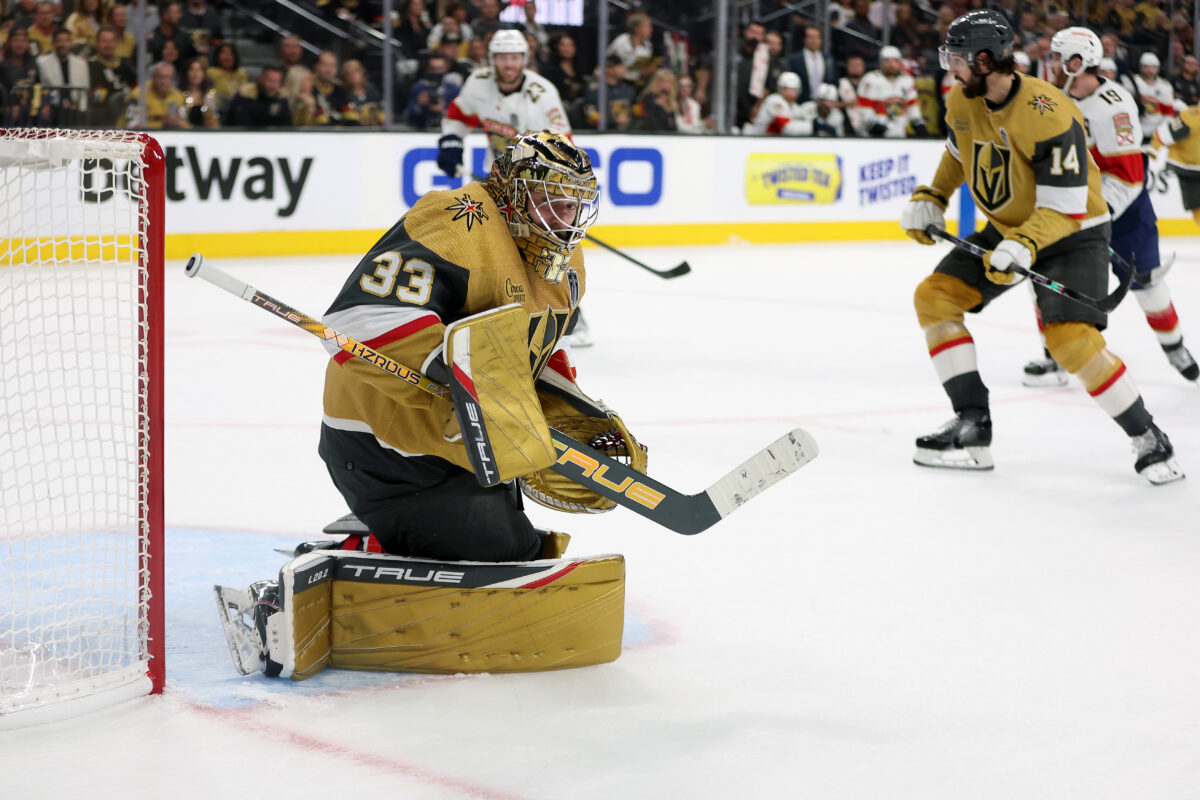Most NHL teams are locked into awkward, uncomfortable contracts with goaltenders who they’d just as soon be rid of. John Gibson has demanded a trade from the Anaheim Ducks with four years and $25.6 million left on his deal. Matt Murray was a prime buyout candidate for the Toronto Maple Leafs but remains in the fold with $6.25 million still owed this season. Even 2020 Vezina Trophy winner Connor Hellebuyck is available as he enters the final year of a contract that will pay him $6.1 million.
The Vegas Golden Knights aren’t immune to this trend. Although they are the envy of the league with Logan Thompson under contract for the next two seasons at a cap hit barely above league minimum, they still have Robin Lehner and the $5 million counted against the cap in each of the next two years.
Once the primary reason that Marc-André Fleury became expendable in Vegas, Lehner had underwhelmed over parts of three injury-marred seasons in the desert before missing all of the Golden Knights’ Cup-winning season in 2022-23 after undergoing double hip surgery. Suddenly, the Swede is a big, soon-to-be 32-year-old question mark who hasn’t seen game action in 15 months and whose health status remains unclear. Here’s a closer look at the Lehner situation.
Could Lehner Stay?
As Vegas learned the hard way last season, you can never have too many goaltenders. While fans may suddenly feel confident in the tandem of Logan Thompson and the newly re-signed Adin Hill, Thompson only appeared in 37 games last season, and Hill still has never started more than 25 games in a season, despite his newfound status as a Cup hero. After Laurent Brossoit left town to sign with the Winnipeg Jets, Lehner could offer some insurance in net.

Beyond the unappealing prospect of paying a third-string goalie $5 million, this scenario would also require some serious cap gymnastics. Assuming Lehner would no longer be eligible for long-term injury reserve (LTIR), general manager Kelly McCrimmon would need to find a way to shave just under $1.5 million off the cap sheet of a club that is carrying only 11 forwards.
Not only would keeping Lehner mean restricted free agents Brett Howden and Pavel Dorofeyev would be let loose, but it would also require cutting subsequent salary from an already-thin roster.
You Might Also Like
- 9 NHL Teams That Missed in Free Agency
- Golden Knights Will Miss Jonathan Marchessault
- Islanders’ Lamoriello Needs to Follow Golden Knights’ Ruthless Trade Model
- Golden Knights Struggling to Address Voids in Forward Corps
- Golden Knights Took Major Risk With 1st-Round Pick Trevor Connelly
How Can Vegas Unload Lehner’s Contract?
July 1 didn’t mark just the opening of free agency, it also marked the end of the league’s buyout window, and the Golden Knights neglected to use that opportunity on Lehner, which was a reasonable decision given all the other factors at play. For one, the organization still found a way to retain playoff standouts Hill and Ivan Barbashev. Moreover, there was – and still is – the possibility that Lehner retires, sparing Vegas the burden of his contract. The team determined that it could play the waiting game rather than commit to buyout terms that would have resulted in a $750,000 cap hit next season, $2.25 million in 2024-25 and then two seasons of $1.75 million.

Without the buyout option, any hope of moving Lehner’s contract will involve finding a taker for most of the $10 million left. It’s not unthinkable that Vegas could find a partner, but such a move would almost certainly require parting with an asset (probably a draft pick or prospect) or taking on a similarly bad contract. A healthy and productive Lehner could be of value to any team seeking goaltending help, but the 12-year veteran doesn’t seem particularly close to that form at the moment.
Perhaps the Golden Knights could continue the tradition of trading useful-but-pricey veterans and getting next to nothing in return (Fleury, Reilly Smith and Max Pacioretty for example). The difference here, however, is that Lehner carries far greater risk given his injury history and performance, and, unlike Fleury and Pacioretty, has two years left on his deal. Furthermore, there are few teams that have goaltending needs and the requisite cap space to take on a contract like Lehner’s. Maybe the Chicago Blackhawks would be interested in a reunion with Connor Bedard now on the roster to boost their rebuild.
Vegas Could Use Lehner’s Cap Space
By getting rid of Lehner, the Golden Knights would effectively be saving $5 million in cap space by unloading a player that doesn’t need to be replaced. Sure, the club would ideally like some secure goaltending depth behind Hill and Thompson, but Jiří Patera might be ready for a bigger role as the third-stringer after proving capable in two appearances last season.
Without the Lehner contract, Vegas would create just over $3.5 million in cap space. That would go a long way toward getting Howden and Dorofeyev under contract or finding some end-of-free-agency value players. If the team wanted to make a splash, they could make a play for Patrick Kane, who seems keen to wait until the season begins to sign a contract but could be swayed to play for the Stanley Cup champions.
Regardless of how the club uses the cap space freed up by shedding Lehner, financial breathing room would represent a refreshing, welcome change from the way the front office has operated in recent years. Placing him back on LTIR would achieve the same result, but his uncertain future – coupled with the prospect of a possible comeback – muddle that option.
On one hand, this is an unfortunate place for the Golden Knights to be in, particularly since they signed Lehner to a five-year deal and parted ways with Fleury to make him the organization’s No. 1 goalie. However, it’s clear that Vegas is doing just fine without him. Having an established goaltender as an extraneous (and expensive) part of the roster isn’t the worst problem to have, but it could still be a problem.
